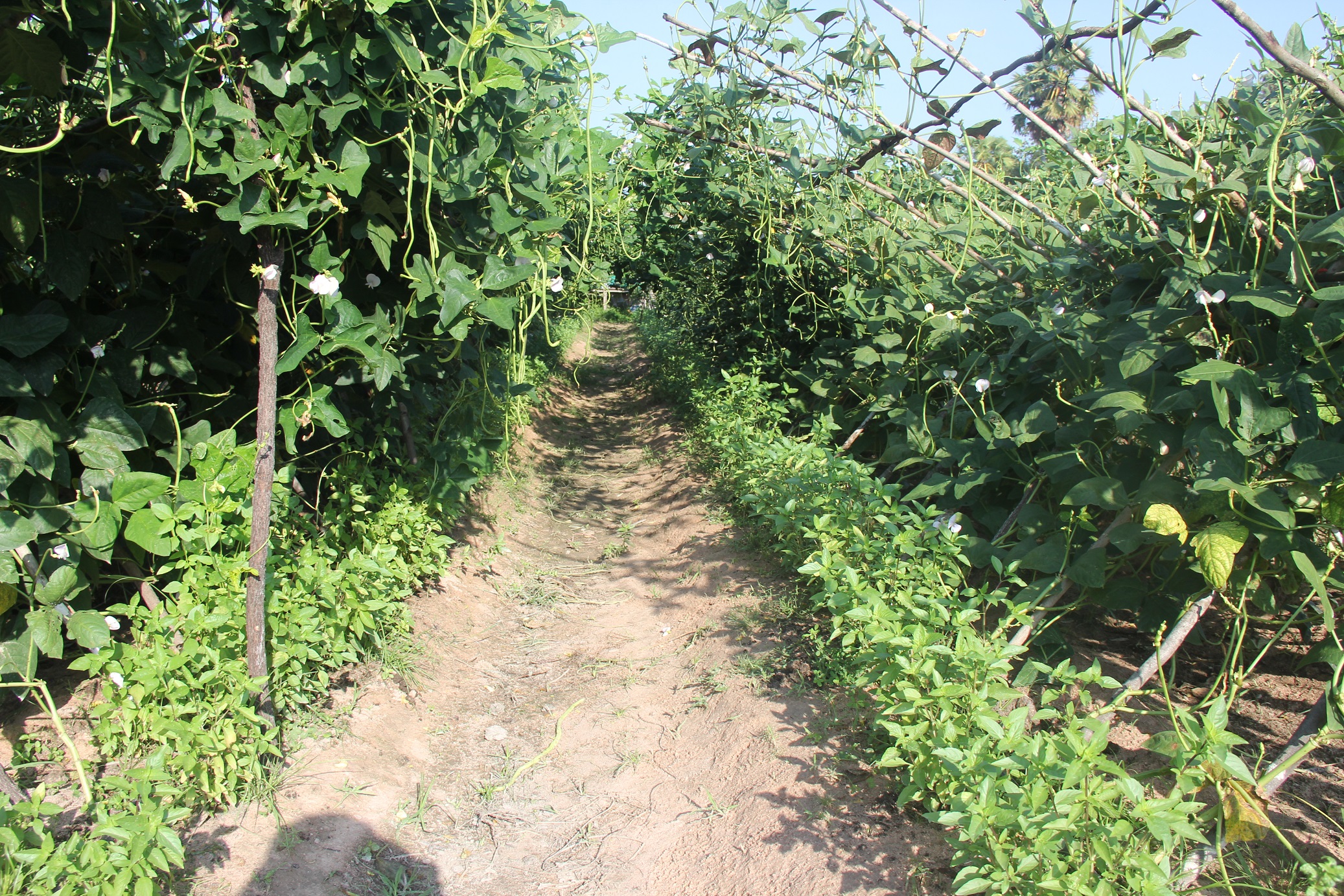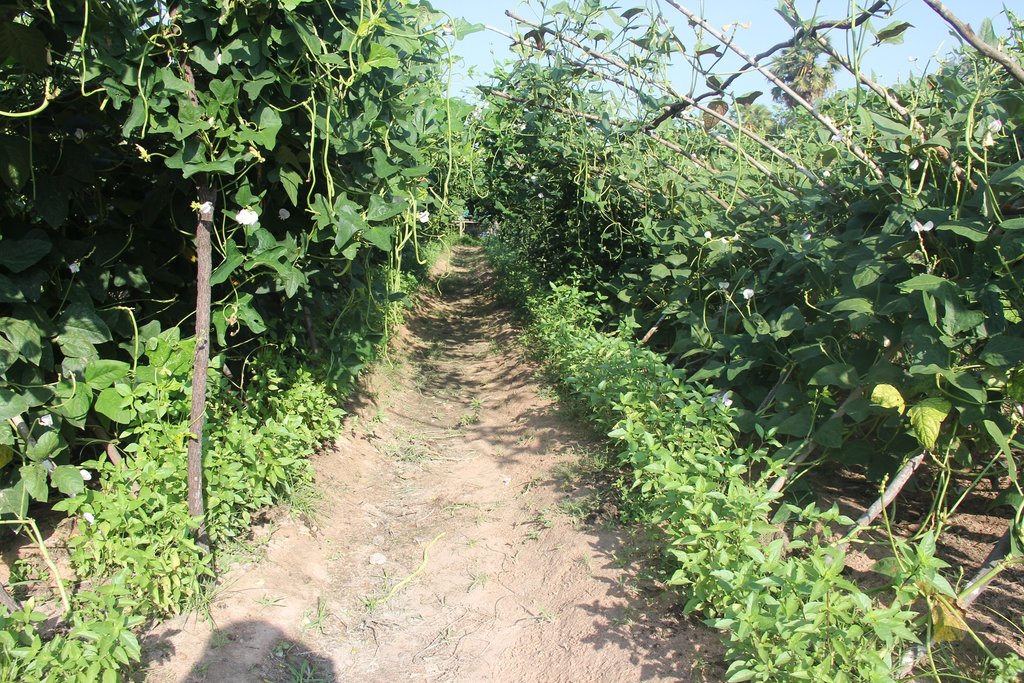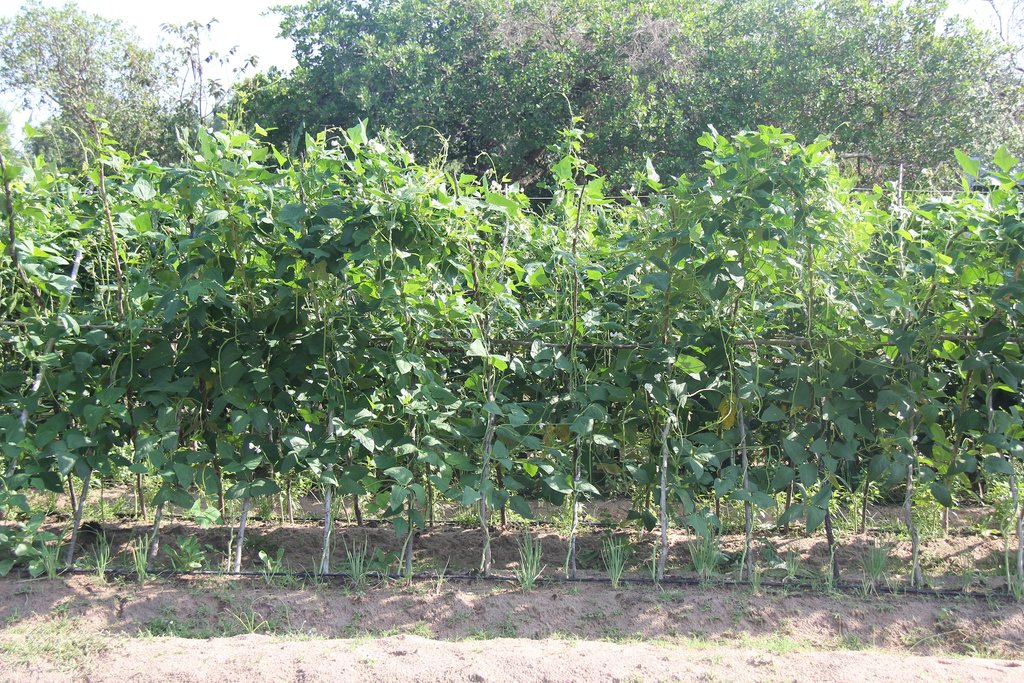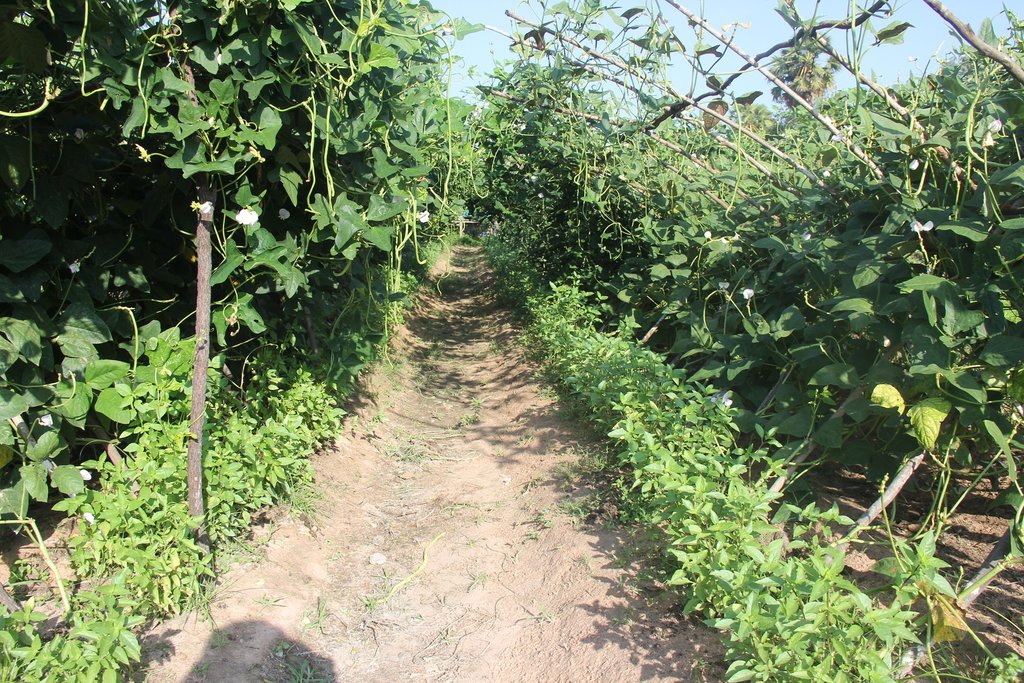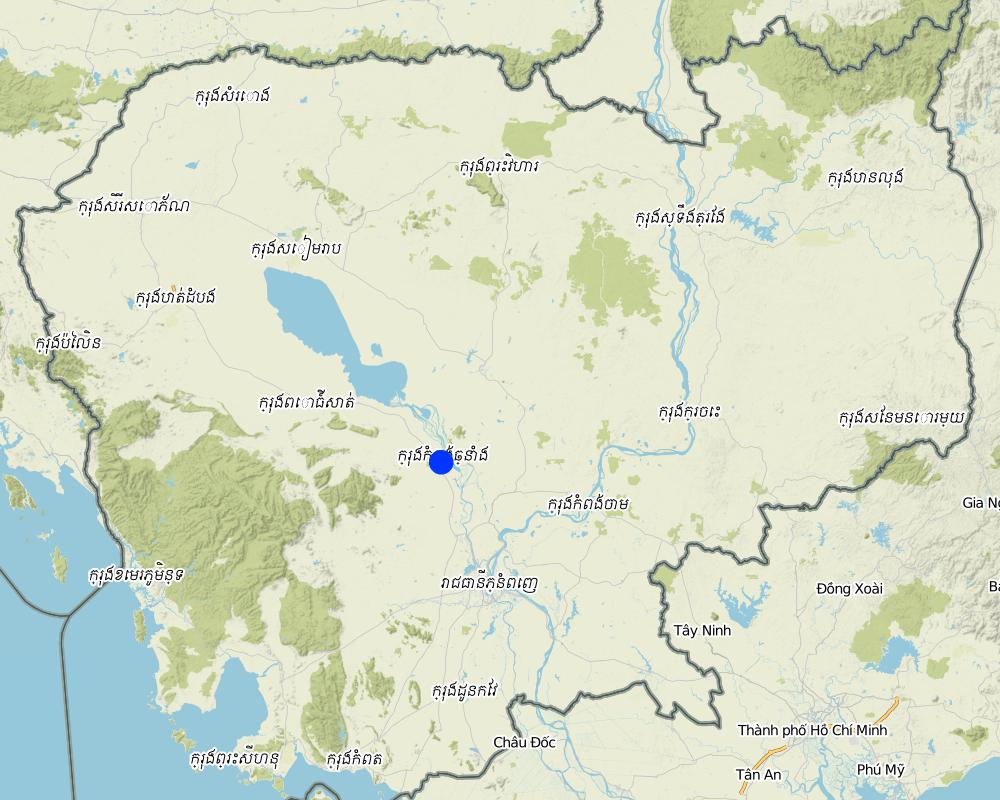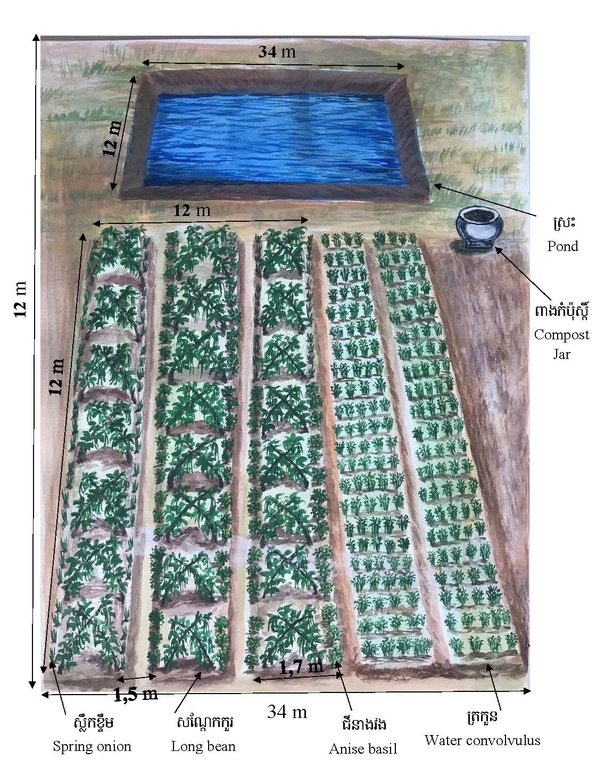ការកែប្រែគុណភាពដីខ្សាច់ដោយប្រើជីធម្មជាតិ និងជីកំប៉ុស្តិ៍ទឹក [كمبوديا]
- تاريخ الإنشاء:
- تحديث:
- جامع المعلومات: Be Gechkim
- المحررون: Navin Chea, Sophea Tim, Sok Pheak
- المراجعون: Nimul CHUN, Ursula Gaemperli, Alexandra Gavilano
ការដាំដំណាំសណ្តែកកួរ
technologies_2949 - كمبوديا
عرض الأقسام
توسيع الكل طي الكل1. معلومات عامة
1.2 تفاصيل الاتصال بالأشخاص الرئيسيين لمصدر المعلومات والمؤسسات المشاركة في تقييم وتوثيق التقنية
الشخص (الأشخاص) الرئيسي لمصدر المعلومات
مستخدم الأرض:
ផល្លី ចាន់
កសិករ
كمبوديا
អនុប្រធានផ្នែកក្សេត្រសាស្ត្រនៅការិយាល័យកសិកម្ម រុក្ខាប្រមាញ់ និងនេសាទ ស្រុករលៀប្អៀរ:
ប៊ុនលៀង ឈឹម
ការិយាល័យកសិកម្មរុក្ខាប្រមាញ់ និងនេសាទស្រុករលៀប្អៀរ
كمبوديا
អនុប្រធានផ្នែកផ្សព្វផ្សាយកសិកម្មនៅមន្ទីរកសិកម្ម រុក្ខាប្រមាញ់ និងនេសាទ ខេត្តកំពង់ឆ្នាំង:
ប្រធានការិយាល័យកសិកម្ម រុក្ខាប្រមាញ់ និងនេសាទ ស្រុកទឹកផុស:
اسم المشروع الذي سهّل توثيق/تقييم التقنية (إذا كان ذلك على صلة)
Scaling-up SLM practices by smallholder farmers (IFAD)اسم المؤسسة (المؤسسات) التي سهلت توثيق/تقييم التقنية (إذا كان ذلك على صلة)
Royal University of Agriculture (RUA) - كمبوديا1.3 الشروط المتعلقة باستخدام البيانات الموثقة من خلال WOCAT
يوافق جامع المعلومات والشخص (لاشخاص) الرئيسي لمصدر المعلومات على الشروط المتعلقة باستخدام البيانات الموثقة من خلال WOCAT:
نعم
1.4 إعلان بشأن استدامة التقنية الموصوفة
هل التقنية الموصوفة هنا تمثل مشكلة فيما يتعلق بتدهور الأراضي، بحيث لا يمكن إعلانها تقنية مستدامة لإدارة الأراضي؟:
كلا
التعليقات:
បច្ចេកទេសនេះអាចចាត់ចូលជាការគ្រប់គ្រងដីប្រកបដោយចីរភាព ព្រោះថាប្រភេទដីពីមុនស្ទើរតែជាប្រភេទដីខ្សាច់ទាំងស្រុង ដែលមិនអាចដាំដំណាំបានសូម្បីតែដំណាំត្រកួន តែក្រោយពីបានប្រើប្រាស់ជីធម្មជាតិ និងកំប៉ុស្តិ៍ទឹកមក ក៏អាចដាំដំណាំបានថែមទាំងទទួលផលល្អទៀតផង។
2. وصف تقنيةالإدارة المستدامي للأراضي
2.1 وصف مختصر للتقنية
تعريف التقنية:
ការកែប្រែគុណភាពដីខ្សាច់តាមរយៈការប្រើជីធម្មជាតិ និងជីកំប៉ុស្តិ៍ទឹកដើម្បីបង្កើនផលិតកម្មដំណាំ គឺជាការផ្លាស់ប្តូរស្ថានភាពដីពីភាពហាប់ណែន ជ្រាបទឹកលឿន និងកង្វះជីជាតិមកជាដីដែលអាចរក្សាសំណើមបានយូរ និងធូរដើម្បីសម្រួលដល់ការស្រូបយកសារធាតុចិញ្ចឹមរបស់ដំណាំ។
2.2 وصف تفصيلي للتقنية
الوصف:
ដីខ្សាច់ជាប្រភេទដីដែលមានភាគល្អិតធំៗ មិនអាចរក្សាសំណើម និងសារធាតុចិញ្ចឹម ដែលជាហេតុធ្វើឱ្យពិបាកក្នុងការដាំដុះ។ ហេតុដូច្នេះហើយការធ្វើកសិកម្មដើម្បីកែប្រែគុណភាពដីត្រូវបានអនុវត្តដោយកសិករ ដើម្បីទទួលបាន ភាពប្រសើរឡើងនៃគុណភាពដី។ ការកែប្រែគុណភាពដី គឺជាដំណើរការបន្ថែមជីជាតិដល់ដី អាចរក្សាសំណើមបានយូរ និងដីផុសជាងមុន សម្រាប់ឱ្យដំណាំលូតលាស់បានល្អ។ ម៉្យាងវិញទៀត ដីខ្សាច់មានភាពហាប់ខ្លាំងដែលធ្វើឱ្យឬសដំណាំពិបាកក្នុងការស្រូបយកជីជាតិពីក្នុងដី។ ដើម្បីជាជំនួយក្នុងការស្រូបយកសារធាតុចិញ្ចឹម ហើយអាចបង្កើនសារធាតុចិញ្ចឹម និងសំណើមដី គេអាចបន្ថែមដីល្បប់ ឬដីភក់ និងពពួកដីដែលសម្បូរកាកសំណល់ពុកផុយទៅលើដីខ្សាច់ទាំងនោះ (Rhoades, 2016)។ ចំណែកកសិករ ក៏មានវិធីសាស្ត្រក្នុងការកែប្រែគុណភាពដីរបស់ខ្លួនឱ្យប្រសើរឡើងផងដែរ ឧទាហរណ៍ដូចជា តាមរយៈការដាំដំណាំផ្សេងៗដោយប្រើប្រាស់ជីធម្មជាតិ និងជីកំបុស្តិ៍ទឹក ជាមួយពពួកដំណាំមានក្លិនឆួល ដែលបានអនុវត្តឡើងនៅក្នុងភូមិព្រៃពួច ដែលស្ថិតក្នុងស្រុករលាប្អៀរ។
គោលបំណងនៃការអនុវត្តបច្ចេកទេសនេះរបស់គាត់ គឺធ្វើយ៉ាងណាដើម្បីធ្វើឱ្យដីខ្សាច់អាចដាំដំណាំបានផលល្អ។ បន្ទាប់ពីការប្រើប្រាស់កំប៉ុស្តិ៍ទឹក និងជីធម្មជាតិ វាជួយបង្កើនជីជាតិដី ហើយកសិករក៏បានបង្កើនប្រភេទមុខដំណាំ និងបរិមាណដំណាំ ក្រោយពេលគុណភាពដីមានភាពប្រសើរឡើងផងដែរ។ ហេតុនេះញ៉ាំងឲ្យសេដ្ឋកិច្ចគ្រួសារបានធូរធារមួយកម្រិត ព្រមទាំងមានដំណាំច្រើនប្រភេទសម្រាប់លក់ទៅតាមតម្រូវការនៅលើទីផ្សារ។
កសិករប្រើជីធម្មជាតិ ដូចជាកាកសំណល់ដំណាំ លាមកសត្វ (លាមកគោ ឬជ្រូកនៅពេលរកមិនបានលាមកគោ)។ បើទោះបីជាលាមកជ្រូកមិនបានផ្តល់សារធាតុចិញ្ចឹមដល់ដីដូចលាមកគោក៏ដោយ តែវាជួយធ្វើឱ្យដីធូរ ដែលងាយឱ្យឬសដំណាំស្រូបយកជីជាតិ និងទឹក ។ ជាងនេះទៅទៀត ដើម្បីឱ្យដីមានជីជាតិ ជីកំបុស្តិ៍ទឹកក៏ត្រូវបានប្រើប្រាស់បន្ថែម ដោយជីកំបុស្តិ៍ទឹកនេះសម្បូរពពួកមីក្រូសរីរាង្គដែលជាអ្នកបំបែកសារធាតុចិញ្ចឹមដ៏ល្អបំផុត។ កសិករបានដាំជាដំណាំសណ្តែកកួរ ឬប្រភេទដំណាំឡើងទ្រើង និងដំណាំយកស្លឹកផ្សេងៗជាលក្ខណៈវិលជុំ និងឆ្លាស់ជាមួយពពួកមានក្លិនឆួល ដូចជាស្លឹកខ្ទឹម និងជីនាងវង (ឬពពួកល្វីង ជូរ ចត់ និងក្លិនក្រពុល) នៅពីខាងក្រោមដំណាំសណ្តែកកួរ ដែលអាចការពារការរាតត្បាតពីសត្វល្អិត ដែលអាចជួយកាត់បន្ថយការប្រើប្រាស់ថ្នាំពុលគីមីបាន។ ការដាំជីនាងវង និងស្លឹកខ្ទឹម នៅលើរងចន្លោះសណ្តែកកួរ និងការដាំដំណាំឆ្លាស់នេះ គឺដើម្បីរក្សាសារធាតុចិញ្ចឹមក្នុងដីផងដែរ។
របៀបធ្វើជីកំបុស្តិ៍ទឹក៖ ត្រូវមានធាតុផ្សំសំខាន់ៗពីរមុខ គឺលាមកសត្វ (មាន់ ឬ ទា) និងស្លឹករុក្ខជាតិ (ពពួក ទន្ទ្រាងខែត្រ ស្លឹកអង្កាញ់ កន្ធំថេត អង្គារដីជាដើម)។ ដាក់ធាតុផ្សំទាំងនោះចូលក្នុងពាង ជាមួយនឹងទឹក២០ដងនៃបរិមាណធាតុផ្សំ រួចគ្របឱ្យជិតការពារការបំភាយក្លិនស្អុយ។ ត្រូវកូរឱ្យបាន ២ដងក្នុងមួយថ្ងៃដើម្បីជួយបំបែកអុកស៊ីសែនឱ្យបានដល់ពពួកមីក្រូសរីរាង្គដែលមាននៅក្នុងជី។ ក្រោយពេល ៣សប្តាហ៍ ជីកំបុស្តិ៍ទឹកនឹងលែងមានក្លិនដែលជាសញ្ញាថាអាចយកមកប្រើប្រាស់បានហើយ។ សម្រាប់ការប្រើ គឺជី ១លីត្រ ស្រោចលើផ្ទៃដី ១ម៉ែត្រការ៉េ ជាធម្មតាជីនេះអាចត្រូវបានប្រើក្នុងពេល ៣សារ នៅពេលដាំ មុនពេលចេញផ្កា និងពេលផ្លែ ឬពេលមានរោគសញ្ញាផ្សេងៗក៏បាន (Yang and Pean, 2015)។
បើប្រៀបធៀបទៅនឹងមុនពេលអនុវត្តបច្ចេកទេសនេះ កសិករមិនអាចដាំបានសូម្បីតែដំណាំត្រកួន ចំណែកឯកម្លាំងពលកម្មក៏មានតម្រូវការខ្ពស់ ហើយបរិមាណទឹកដែលត្រូវការសម្រាប់ការស្រោចស្រពក៏ច្រើនដែរ។ បច្ចេកទេសនេះជួយទាំងគុណភាពដី កាត់បន្ថយការចំណាយលើជី និងថ្នាំគីមី កម្លាំងពលកម្ម និងចំណេញផ្ទៃដីដាំ។
2.3 صور التقنية
2.4 فيديوهات عن التقنية
تعليقات، وصف موجز:
មិនមាន
اسم مصور الفيديو:
មិនមាន
2.5 البلد/المنطقة/المواقع التي تم تنفيذ التقنية فيها والتي يغطيها هذا التقييم
البلد:
كمبوديا
المنطقة/الولاية/المحافظة:
ភូមិព្រៃពួច ឃុំជ្រៃបាក់ ស្រុករលាប្អៀរ ខេត្តកំពង់ឆ្នាំង
حدد انتشار التقنية:
- منتشرة بالتساوي على مساحة
إذا كانت التقنيةا موزعة بالتساوي على منطقة ما، حدد المساحة المغطاة (بالكيلومتر المربع):
0,00036
التعليقات:
អនុវត្តត្រឹមទំហំទទឹង ១២ ម៉ែត្រ និងបណ្តោយ ៣០ ម៉ែត្រ
Map
×2.6 تاريخ التنفيذ
اذكر سنة التنفيذ:
2016
2.7 إدخال التقنية
حدد كيف تم إدخال التقنية:
- من خلال ابتكار مستخدمي الأراضي
التعليقات (نوع المشروع، الخ):
គាត់ជាអតីតមន្ត្រីផ្សព្វផ្សាយកសិកម្មដែលពេញទៅដោយបទពិសោធន៍។
3. تصنيف تقنية الإدارة المستدامي للأراضي
3.1 الغرض الرئيسي ( الأغراض الرئيسية) للتقنية
- تحسين الإنتاج
- الحد من تدهور الأراضي ومنعه وعكسه
- خلق أثر اقتصادي مفيد
3.2 نوع (أنواع) استخدام الأراضي الحالية حيث يتم تطبيق التقنية

الأراضي الزراعية
- زراعة سنوية
الزراعة السنوية - حدد المحاصيل:
- الحبوب البقولية والبقول- الفاصوليا
- النباتات والأعشاب الطبية والعطرية والمبيدة للحشرات
- الخضروات - الخضروات الجذرية (الجزر والبصل والشمندر وغيرها)
عدد مواسم الزراعة في السنة:
- 3
حدد:
សណ្តែកកួរប្រមូលផលបន្ទាប់ពីដាំបាន ៦០ទៅ៦៥ថ្ងៃ ហើយប្រមូលផលបានពី១៥ ទៅ១៨សារ ចំណែកឯជីនាងវង ២៥ ថ្ងៃ អាចប្រមូលផលបានហើយ។ ស្លឹកខ្ទឹមដាំរយៈពេល ៣០ថ្ងៃប្រមូលផលបាន ហើយប្រមូលផលបាន ១,៥ខែ (១០ទៅ២០ សារ)។
3.3 هل تغير استخدام الأراضي نتيجة لتنفيذ التقنية؟
هل تغير استخدام الأراضي نتيجة لتنفيذ التقنية؟:
- نعم (يرجى ملء الأسئلة أدناه فيما يتعلق باستخدام الأراضي قبل تنفيذ التقنية)

الأراضي الزراعية
التعليقات:
ជាប្រភេទដីស្រែ ហើយមិនសូវទទួលផលដោយសារជាប្រភេទដីខ្សាច់។
3.4 إمدادات المياه
إمدادات المياه للأرض التي يتم تنفيذ التقنية عليها:
- مختلط بعلي-مروي
التعليقات:
ទទួលបានទឹកស្រោចស្រពពីស្រះ និងអណ្តូងស្នប់
3.5 مجموعةالإدارة المستدامة للأراضي التي تنتمي إليها هذه التقنية
- أنظمة التناوب (تعاقب المحاصيل، البور، الزراعة المتنقلة)
- الإدارة المتكاملة لخصوبة التربة
- الإدارة المتكاملة للآفات والأمراض (بما في ذلك الزراعة العضوية)
3.6 التدابير التقنية في مجال إلادارة المستدامة للأراضي

التدابير الزراعية
- A1: الغطاء النباتي/التربة
- A2: المادة العضوية/خصوبة التربة

التدابير البنيوية
- S7: معدات حصاد المياه/الإمداد/الري
3.7 الأنواع الرئيسية من تدهور الأراضي التي تناولتها التقنية

التدهور الكيميائي للتربة
- (Cn): تراجع الخصوبة وانخفاض محتوى المادة العضوية (غير ناتج عن الانجراف)

تدهور المياه
- (Ha): التجفيف
3.8 منع أو حد أو عكس تدهور الأراضي
تحديد هدف التقنية فيما يتعلق بتدهور الأراضي:
- اصلاح/إعادة تأهيل الأراضي المتدهورة بشدة
التعليقات:
ដោយប្រើប្រាស់ជីកំប៉ុស្តិ៍ លាមកគោ មាន់ ជ្រូក និងលាយជាមួយដីដំបូកសម្រាប់ដាំដំណាំដើម្បីកែប្រែគុណភាពដី។
4. المواصفات الفنية، وأنشطة التنفيذ، والمدخلات، والتكاليف
4.1 الرسم الفني للتقنية
المواصفات الفنية (المتعلقة بالرسم الفني):
បច្ចេកទេសនេះត្រូវបានអនុវត្តនៅលើផ្ទៃដីដែលមានបណ្តោយ ៥២ម៉ែត្រ និងទទឹង ៣៤ម៉ែត្រ ដែលមានស្រះទឹកមួយនៅខាងក្រោយមានទទឹង ២២ម៉ែត្រ បណ្តោយ ៣៤ម៉ែត្រ និងជម្រៅ ៥ម៉ែត្រ។ នៅក្នុងទំហំដីសល់ពីស្រះជាដីដាំសណ្តែកកួរដែលមានបណ្តោយ ៣០ម៉ែត្រ និងទទឹង ១២ម៉ែត្រ។ រងសណ្តែកនោះមានទទឹង ១,៧ម៉ែត្រ ចន្លោះរង ១,៥ម៉ែត្រ កម្ពស់រង ៣០សង់ទីម៉ែត្រ ហើយចន្លោះគុម្ព ៤០សង់ទីម៉ែត្រ។ ផ្ទៃដីដាំសណ្តែកកួរនេះមានសណ្តែកកួរចំនួន ៣រង ត្រូវជា ៦ជួរ ក្នុងជួរនីមួយៗមានចន្លោះប្រវែង ៤០សង់ទីម៉ែត្រ និងមានដាំជីនាងវង និងស្លឹកខ្ទឹមនៅចន្លោះគុម្ពសណ្តែកកួរទាំងនោះ។ របៀបធ្វើជីកំបុស្តិ៍ទឹក៖ ត្រូវមានធាតុផ្សំសំខាន់ៗពីរមុខ គឺលាមកសត្វ (មាន់ ឬ ទា) និង ស្លឹករុក្ខជាតិ (ពពួក ទន្រ្ទាងខែត្រ ស្លឹកអង្កាញ់ កន្ធំថេត អង្គារដីជាដើម)។ ដាក់ធាតុផ្សំទាំងនោះចូលក្នុងពាង ជាមួយនឹងទឹក ២០ដងនៃបរិមាណធាតុផ្សំ រួចគ្របឱ្យជិតការពារការបំភាយក្លិនស្អុយ។ ត្រូវកូរឱ្យបាន ២ដងក្នុងមួយថ្ងៃដើម្បីជួយបំបែកអុកស៊ីសែនឱ្យបានដល់ពពួកមីក្រូសរីរាង្គដែលមាននៅក្នុងជី។ ក្រោយពេល ៣សប្តាហ៍ ជីកំបុស្តិ៍ទឹកនឹងលែងមានក្លិនដែលជាសញ្ញាថាអាចយកមកប្រើប្រាស់បានហើយ។ សម្រាប់ការប្រើ គឺជី ១លីត្រ ស្រោចលើផ្ទៃដី ១ម៉ែត្រការ៉េ ជាធម្មតាជីនេះអាចត្រូវបានប្រើក្នុងពេល ៣សារ នៅពេលដាំ មុនពេលចេញផ្កា និងពេលផ្លែ ឬពេលមានរោគសញ្ញាផ្សេងៗក៏បាន។
المؤلف:
លោក ឃួន សុផល
التاريخ:
25/05/2017
4.2 معلومات عامة بخصوص حساب المدخلات والتكاليف
حدد كيفية احتساب التكاليف والمدخلات:
- حسب مساحة تنفيذ التقنية
الإشارة إلى حجم ووحدة المساحة:
១២ X ៣០ = ៣៦០ ម៉ែត្រការ៉េ
عملة أخرى/ عملة وطنية (حدد):
រៀល
إذا كان ذا صلة، وضح سعر الصرف من الدولار الأمريكي إلى العملة المحلية (على سبيل المثال، 1 دولار أمريكي = 79.9 ريال برازيلي): 1 دولار أمريكي =:
4000,0
اذكر متوسط تكلفة أجر العمالة المستأجرة في اليوم الواحد:
25000 រៀល
4.3 أنشطة التأسيس
| النشاط | التوقيت (الموسم) | |
|---|---|---|
| 1. | ភ្ជួរដីហាល | ខែឧសភា |
| 2. | បាចកំបោរ | ខែឧសភា |
| 3. | លើករង | ខែឧសភា |
| 4. | ដាក់លាមកគោ និងដីដំបូក | ខែឧសភា |
| 5. | ការរៀបប្រព័ន្ធតំណក់ទឹក | ខែឧសភា |
| 6. | លើកទ្រើង | ខែឧសភា |
| 7. | បណ្តុះកូន | ខែឧសភា |
4.4 التكاليف والمدخلات اللازمة للتأسيس
| تحديد المدخلات | الوحدة | الكمية | التكاليف لكل وحدة | إجمالي التكاليف لكل مدخل | % من التكاليف التي يتحملها مستخدمو الأراضي | |
|---|---|---|---|---|---|---|
| العمالة | ភ្ជួរដីហាល | សារ | 3,0 | 20000,0 | 60000,0 | 100,0 |
| العمالة | លើករងនិងបាចកំបោរ | ថ្ងៃ | 2,0 | 25000,0 | 50000,0 | 100,0 |
| العمالة | រៀបប្រព័ន្ធតំណក់ទឹក | ថ្ងៃ | 1,0 | 25000,0 | 25000,0 | 100,0 |
| معدات | ចបជីក | ចប | 1,0 | 15000,0 | 15000,0 | 100,0 |
| معدات | ចបកាប់ | ចប | 1,0 | 20000,0 | 20000,0 | 100,0 |
| معدات | ប៊ែល | ប៊ែល | 1,0 | 20000,0 | 20000,0 | 100,0 |
| المواد النباتية | គ្រាប់ពូជសណ្តែកកួរ | កញ្ចប់ | 1,0 | 10000,0 | 10000,0 | 100,0 |
| المواد النباتية | ស្លឹកខ្ទឹម | គីឡូក្រាម | 3,0 | 4000,0 | 12000,0 | 100,0 |
| المواد النباتية | ថាសបណ្តុះកូន | ថាស | 6,0 | 4000,0 | 24000,0 | 100,0 |
| الأسمدة والمبيدات الحيوية | លាមកគោ | រទេះ | 6,0 | 20000,0 | 120000,0 | 100,0 |
| الأسمدة والمبيدات الحيوية | ជី DAP | គីឡូក្រាម | 5,0 | 3000,0 | 15000,0 | 100,0 |
| الأسمدة والمبيدات الحيوية | ជី KCL | គីឡូក្រាម | 5,0 | 3000,0 | 15000,0 | 100,0 |
| الأسمدة والمبيدات الحيوية | ជីអ៊ុយរ៉េ | គីឡូក្រាម | 5,0 | 3500,0 | 17500,0 | 100,0 |
| مواد البناء | ប្រព័ន្ធតំណក់ទឹក | ឈុត | 1,0 | 110000,0 | 110000,0 | 100,0 |
| مواد البناء | បំពង់ទីប | ដើម | 2,0 | 20000,0 | 40000,0 | 100,0 |
| مواد البناء | មែកឈើសម្រាប់ធ្វើទ្រើង | ដើម | 225,0 | 300,0 | 67500,0 | 100,0 |
| مواد البناء | ធុងទឹក | ធុង | 2,0 | 6000,0 | 12000,0 | 100,0 |
| إجمالي تكاليف إنشاء التقنية | 633000,0 | |||||
| إجمالي تكاليف إنشاء التقنية بالدولار الأمريكي | 158,25 | |||||
إذا لم تتمكن من تفصيل التكاليف في الجدول أعلاه، قم بتقديم تقدير للتكاليف الإجمالية لإنشاء التقنية:
3600000,0
4.5 الصيانة/الأنشطة المتكررة
| النشاط | التوقيت/الوتيرة | |
|---|---|---|
| 1. | ធ្វើស្មៅ | រាល់២ សប្តាហ៍ម្តង |
| 2. | ជ្រោយជើងដាក់លាមកគោ និងជីកំប៉ុស្តិ៍ | ១វដ្ដដំណាំម្ដងពេលដំណាំអាយុ ១០ ទៅ ១៥ថ្ងៃ |
| 3. | កាត់ខ្នែងក្រោម | នៅអាយុ ២០ ទៅ ២៥ថ្ងៃ |
| 4. | ដាក់ DAP, KCL | ដាក់ ៣ដង នៅពេលដាំ ពេលចេញផ្កា និងផ្លែ |
| 5. | ធ្វើថ្នាំសម្លាប់សត្វល្អិត និងបាញ់ | ធ្វើនៅពេលមានសត្វល្អិតបំផ្លាញ |
| 6. | បាញ់ថ្នាំសត្វល្អិត (ស្រឹង ចៃ ស្រាំងទិច) | បាញ់ថ្នាំនៅពេលមានសត្វល្អិតបំផ្លាញ |
التعليقات:
ក្នុងការធ្វើថ្នាំសម្លាប់សត្វល្អិត កសិករប្រើសាប៊ូ ៣ក្រាម ប្រេងឆា ៣ស្លាបព្រា ម្ទេស ៣ ទៅ ៤ គ្រាប់ ជាមួយទឹក ១លីត្រ។
4.6 التكاليف والمدخلات اللازمة للصيانة/للأنشطة المتكررة (سنويًا)
إذا لم تتمكن من تفصيل التكاليف في الجدول أعلاه، قدم تقديرًا للتكاليف الإجمالية لصيانة التقنية:
400000,0
4.7 أهم العوامل المؤثرة على التكاليف
قدم وصفا لأهم العوامل التي تؤثر على التكاليف:
ការរៀបចំប្រព័ន្ធស្រោចស្រព (តំណក់ទឹក)
5. البيئة الطبيعية والبشرية
5.1 المناخ
هطول الأمطار السنوي
- < 250 مم
- 251- 500 ملم
- 501 - 750ملم
- 1,000-751 ملم
- 1,500-1,100 ملم
- 2,000-1,500 ملم
- 3,000-2,001 ملم
- 4,000-3,100 ملم
- > 4000 ملم
حدد متوسط هطول الأمطار السنوي (إذا كان معروفًا)، بالملليمتر:
1209,00
المواصفات/التعليقات على هطول الأمطار:
បរិមាណទឹកភ្លៀងប្រចាំឆ្នាំ ២០១៥ មានចំនួន ១២០៩ មម ឆ្នាំ ២០១៤ មានចំនួន ១៤២០.៧៤ មម និងឆ្នាំ ២០១៣ មានចំនួន ១៣៦៧.៥ មម។
الإشارة إلى اسم محطة الأرصاد الجوية المرجعية المعنية:
ក្រសួងធនធានទឹក និងឧតុនិយម (២០១៥)
المنطقة المناخية الزراعية
- شبه قاحلة
5.2 طوبوغرافيا
متوسط الانحدارات:
- مسطح (0-2%)
- بسيط (3-5%)
- معتدل (6-10%)
- متدحرج (11-15%)
- تلال (16-30%)
- شديدة الانحدار(31-60%)
- فائقة الانحدار (>60%)
التضاريس:
- هضاب/سهول
- أثلام مرتفعة
- المنحدرات الجبلية
- منحدرات التلال
- منحدرات في السفوح
- قاع الوادي
المنطقة الارتفاعية:
- 100-0 متر فوق سطح البحر
- 500-101 متر فوق سطح البحر
- 1,000-501 متر فوق سطح البحر
- 1,500-1,001 متر فوق سطح البحر
- 2,000-1,501 متر فوق سطح البحر
- 2,500-2,100 متر فوق سطح البحر
- 3,000-2,501 متر فوق سطح البحر
- 4,000-3,001 متر فوق سطح البحر
- > 4000 متر فوق سطح البحر
وضح ما إذا كانت التقنية مطبقة على وجه التحديد في:
- غير ذات صلة
5.3 التربة
متوسط عمق التربة:
- ضحل جدًا (0-20 سم)
- ضحلة (21-50 سم)
- متوسطة العمق (51-80 سم)
- عميقة (81-120 سم)
- عميقة جدًا (> 120 سم)
قوام التربة (التربة السطحية):
- متوسط ( طميي، سلتي)
قوام التربة (> 20 سم تحت السطح):
- خشن / خفيف (رملي)
المواد العضوية في التربة السطحية:
- متوسطة (1-3%)
إذا كان متاحًا، قم بإرفاق وصف كامل للتربة أو تحديد المعلومات المتوفرة، على سبيل المثال نوع التربة، الرقم الهيدروجيني/ درجة حموضة التربة، قدرة التبادل الكاتيوني، النيتروجين، الملوحة وما إلى ذلك.
pH=៦,៥ និងជាប្រភេទដីខ្សាច់រហូតដល់ជម្រៅ ២ម៉ែត្រ ប៉ុន្តែបច្ចុប្បន្នដីស្រទាប់លើប្រសើរជាងមុន។
5.4 توافر المياه ونوعيتها
منسوب المياه الجوفية:
50-5 م
توافر المياه السطحية:
جيد
نوعية المياه (غير المعالجة):
مياه شرب جيدة
هل تعتبر ملوحة الماء مشكلة؟:
كلا
هل تحدث فيضانات في المنطقة؟:
كلا
5.5 التنوع البيولوجي
التعليقات والمواصفات الإضافية بشأن التنوع البيولوجي:
មិនទាក់ទង
5.6 خصائص مستخدمي الأراضي الذين يطبقون التقنية
مستقر أو مرتحل:
- غير المترحل
التوجه السوقي لنظام الإنتاج:
- مختلط (كفاف/ تجاري)
الدخل من خارج المزرعة:
- 10-50% من جميع الإيرادات
المستوى النسبي للثروة:
- ثري
أفراداً أو مجموعات:
- فرد/أسرة معيشية
مستوى المكننة:
- عمل يدوي
الجنس:
- رجال
عمر مستخدمي الأرضي:
- كبار السن
اذكر الخصائص الأخرى ذات الصلة لمستخدمي الأراضي:
គាត់មានអាយុប្រមាណ 54 ឆ្នាំ។
5.7 متوسط مساحة الأرض التي يستخدمها مستخدمو الأراضي الذين يطبقون التقنية
- < 0.5 هكتارا
- 0.5 - 1 هكتار
- 1 -2 هكتار
- 2 - 5 هكتار
- 5 - 15 هكتار
- 15 - 50 هكتار
- 50 - 100هكتار
- 500-100 هكتار
- 1,000-500 هكتار
- 10,000-1,000 هكتار
- > 10,000 هكتار
هل يعتبر هذا نطاقًا صغيرًا أو متوسطًا أو واسعا (في إشارة إلى السياق المحلي)؟:
- على نطاق صغير
التعليقات:
ដីដាំដំណាំសរុប 70អា ដីស្រែ 3អា និងដីព្រៃ 2អា។
5.8 ملكية الأراضي، وحقوق استخدام الأراضي، وحقوق استخدام المياه
ملكية الارض:
- فردية، يوجد سند ملكية
حقوق استخدام الأراضي:
- فردي
حقوق استخدام المياه:
- فردي
5.9 الوصول إلى الخدمات والبنية التحتية
الصحة:
- ضعيف
- معتدل
- جيد
التعليم:
- ضعيف
- معتدل
- جيد
المساعدة التقنية:
- ضعيف
- معتدل
- جيد
العمل (على سبيل المثال خارج المزرعة):
- ضعيف
- معتدل
- جيد
الأسواق:
- ضعيف
- معتدل
- جيد
الطاقة:
- ضعيف
- معتدل
- جيد
الطرق والنقل:
- ضعيف
- معتدل
- جيد
مياه الشرب وخدمات الصرف الصحي:
- ضعيف
- معتدل
- جيد
الخدمات المالية:
- ضعيف
- معتدل
- جيد
6. الآثار والتصريحات الختامية
6.1 الآثار التي أظهرتها التقنية في الموقع
الآثار الاجتماعية والاقتصادية
الإنتاج
إنتاج المحاصيل
التعليقات/ حدد:
ប្រើលាមកសត្វ និងជីកំប៉ុស្តិ៍ទឹក
خطر فشل الإنتاج
تنوع المنتج
الدخل والتكاليف
دخل المزرعة
التعليقات/ حدد:
ដីផុស និងមានជីជាតិដែលធ្វើឱ្យដំណាំទទួលបានទិន្នផលកើនឡើង។
تنوع مصادر الدخل
التعليقات/ حدد:
ដាំដំណាំច្រើនមុខដែលបង្កើនប្រភពចំណូលច្រើនដែរ។
فروقات اقتصادية
التعليقات/ حدد:
កាលពីមុនកសិករមានជីវភាពលំបាកដោយសារគាត់ដីរបស់គាត់ជាប្រភេទដីខ្សាច់មិនអាចដាំដុះបាន។ ការបង្កើនជីជាតិដីនេះក៏បានជួយបង្កើនជីវភាពគ្រួសាររបស់គាត់ដែរ។
عبء العمل
التعليقات/ حدد:
សម្រួលបន្ទុកការងារដោយប្រើប្រាស់ប្រព័ន្ធតំណក់ទឹក និងការដាំជីជួយកាត់បន្ថយស្មៅនិងសត្វល្អិត។
الآثار الاجتماعية والثقافية
الأمن الغذائي / الاكتفاء الذاتي
التعليقات/ حدد:
ទទួលបានបន្លែស្រស់ៗ និងមានចំណូលជាប្រចាំ
الوضع الصحي
التعليقات/ حدد:
មិនដែលមានបញ្ហាសុខភាពឡើយ
استخدام الأراضي / حقوق المياه
التعليقات/ حدد:
មានអណ្ដូងទឹកសម្រាប់ប្រើប្រាស់តាំងពីមុន
الفرص الترفيهية
التعليقات/ حدد:
ក្រោយពីឈប់ពីការងាររដ្ឋត្រលប់មកធ្វើកសិកម្មវិញកុំអោយទំនេរនិងជាលំហាត់ប្រាណផង។
المعرفة بالإدارة المستدامة للأراضي/تدهور الأراضي
الآثار الايكولوجية
دورة المياه / الجريان السطحي
كمية المياه
التعليقات/ حدد:
បើទោះជាមានការដាំដំណាំច្រើនប្រភេទក៏ដោយតែបរិមាណទឹកមិនមានកង្វះខាតសម្រាប់ប្រើប្រាស់ឡើយ។
جودة المياه
التعليقات/ حدد:
មិនប្រើប្រាស់ជីគីមីដែលធ្វើឱ្យប៉ះពាល់ដល់គុណភាពទឹកនោះទេ។
تصريف المياه الزائدة
التعليقات/ حدد:
ប្រើប្រាស់ប្រព័ន្ធតំណក់ទឹក
التربة
رطوبة التربة
التعليقات/ حدد:
ដាំដំណាំច្រើនធ្វើជាគម្របដីដែលជួយបង្កើនសំណើមដី។ ម៉្យាងទៀតលាមកសត្វក៏បានជួយបង្កើនជីជាតិដីផងដែរ។
غطاء التربة
التعليقات/ حدد:
មិនទុកដីឱ្យទំនេរដូចមុន
تراص التربة
التعليقات/ حدد:
ដីធូរជាងមុនដោយប្រើលាមកសត្វ និងកំប៉ុស្តិ៍ ហើយវាក៏ជួយឱ្យប្រសើរឡើងនូវទម្រង់ដី។
دورة المغذيات/إعادة الشحن
التعليقات/ حدد:
ប្រើលាមកសត្វ និងកំប៉ុស្តិ៍
المادة العضوية في التربة/تحت الطبقة c
التعليقات/ حدد:
ប្រើលាមកសត្វ និងកំប៉ុស្តិ៍រាល់ពេលដាំ
التنوع البيولوجي: الغطاء النباتي، الحيوانات
الغطاء النباتي
التعليقات/ حدد:
កាលពីមុនដាំតែត្រកួនមិនបានទទួលផលផង តែឥលូវដាំដំណាំបានច្រើនមុខដែលជួយកាត់បន្ថយការហូរច្រោះដីទៀតផង។
التنوع النباتي
التعليقات/ حدد:
ដាំដំណាំច្រើនមុខ និងផ្លាស់ប្ដូរប្រភេទដំណាំ
الأنواع الدخيلة الغازية
التعليقات/ حدد:
ដោយប្រើការដាំជីដែលជាពពួកមានក្លិន តែវាជួយកាត់បន្ថយបានតិចតួចប៉ុណ្ណោះ។
الأنواع المفيدة
التعليقات/ حدد:
ឃើញសម្បូរជន្លេនជាងមុន
مكافحة الآفات/الأمراض
التعليقات/ حدد:
កាត់បន្ថយបានខ្លះប៉ុណ្ណោះដោយមានដាំពពួកមានក្លិនឆួលពីក្រោម។
6.2 الآثار التي أظهرتها التقنية خارج الموقع
قيّم الآثار خارج الموقع (القياسات):
មិនមានជាបញ្ហាផ្សេងៗទៅដល់បរិវេណក្រៅបច្ចេកទេសនោះទេ។
6.3 تعرض التقنية وحساسيتها لتغير المناخ التدريجي والظواهر المتطرفة/الكوارث المرتبطة بالمناخ (كما يراها مستخدمو الأراضي)
تغير مناخ تدريجي
تغير مناخ تدريجي
| الموسم | زيادة أو نقصان | كيف تتعامل التقنية مع ذلك؟ | |
|---|---|---|---|
| درجة الحرارة السنوية | زيادة | جيدا | |
| هطول الأمطار السنوي | غير معروف |
الظواهر المتطرفة / الكوارث المرتبطة بالمناخ
الكوارث المناخية
| كيف تتعامل التقنية مع ذلك؟ | |
|---|---|
| موجة حر | جيدا |
الكوارث البيولوجية
| كيف تتعامل التقنية مع ذلك؟ | |
|---|---|
| أمراض وبائية | جيدا |
التعليقات:
មានការផ្លាស់ប្ដូរដំណាំតាមភាពធន់របស់ដំណាំទៅនឹងកំណើនកម្ដៅ។
6.4 تحليل التكلفة والعائد
كيف يمكن مقارنة العوائد نسبة لتكاليف الإنشاء (من وجهة نظر مستخدمي الأراضي)؟
عوائد قصيرة الأجل:
إيجابي قليلا
عوائد طويلة الأجل:
إيجابي
كيف تتم مقارنة العوائدمع كلفة الصيانة/التكاليف المتكررة (من وجهة نظر مستخدمي الأراضي)؟
عوائد قصيرة الأجل:
إيجابي
عوائد طويلة الأجل:
إيجابي
6.5 اعتماد التقنية
- حالات فردية/تجريبية
من بين جميع الذين تبنوا التقنية، كم عدد الذين فعلوا ذلك بشكل تلقائي، أي دون تلقي أي حوافز مادية/مدفوعات؟:
- 91-100%
التعليقات:
នៅក្នុងភូមិមានតែផ្ទះកសិកររូបនេះប៉ុណ្ណោះដែលធ្វើកសិកម្មបែបនេះ ក្រៅពីនោះមិនមានអ្នកចាប់អារម្មណ៍ឡើយ។
6.6 التكيف
هل تم تعديل التقنية مؤخرًا لتتكيف مع الظروف المتغيرة؟:
كلا
6.7 نقاط القوة / المزايا / الفرص التي توفرها التقنية
| نقاط القوة/ المزايا/ الفرص من وجهة نظر مستخدمي الأراضي |
|---|
| បង្កើនប្រាក់ចំណូលក្នុងគ្រួសារ |
| មិនប៉ះពាល់ដល់សុខភាពដោយមិនប្រើជី ឬថ្នាំគីមី |
| ជួយកាត់បន្ថយការនាំដំណាំចូលពីក្រៅ |
| نقاط القوة/ المزايا/ الفرص من وجهة نظر جامع المعلومات أو غيره من الاشخاص الرئيسيين لمصدر المعلومات |
|---|
| អាចជួយកាត់បន្ថយសត្វល្អិតមួយចំនួនដោយមានដាំពពួកមានក្លិនដូចជាជី និងខ្ទឹម |
| បង្កើនជីជាតិដី និងរក្សាគុណភាពដីដោយផ្លាស់ប្តូរដំណាំ និងប្រើប្រាស់លាមកសត្វ និងជីកំប៉ុស្តិ៍ |
| ទទួលបានចំណូលបន្ថែម និងស្រួលលក់ |
6.8 نقاط ضعف / مساوىء / مخاطر التقنية وسبل التغلب عليها
| نقاط الضعف/ المساوىء/ المخاطر من وجهة نظر مستخدم الأراضي | كيف يمكن التغلب عليها؟ |
|---|---|
| នៅមានពពួកសត្វល្អិតមួយចំនួនទៀត | ប្រើប្រាស់ថ្នាំសំលាប់សត្វល្អិតដែលផលិតដោយកសិករផ្សំពីរុក្ខជាតិ។ |
7. المراجع والروابط
7.1 طرق جمع/مصادر المعلومات
- زيارات ميدانية، مسوحات ميدانية
១កន្លែង
- مقابلات مع مستخدمي الأراضي
១នាក់
- مقابلات مع المتخصصين/الخبراء في الإدارة المستدامة للأراضي
៣នាក់
متى تم تجميع البيانات (ميدانيا)؟:
22/05/2017
7.2 المراجع للمنشورات المتاحة
العنوان، المؤلف، السنة، النظام القياسي الدولي لترقيم الكتب ISBN:
Yang S. and Pean S. (2015) Kit of Simple Agriculture Technologies. CEDAC. (In Khmer)
متاح من أين؟كم التكلفة؟:
Can find out at CEDAC, cost 10000 Riel
7.3 روابط للمعلومات ذات الصلة على الإنترنت
العنوان/الوصف:
Rhoades H. (2016) Sandy Soil Amendments: How to do sandy soil improvement. Gardening.
عنوان الرابط URL:
Retrieved on July 18 from: https://www.gardeningknowhow.com/garden-how-to/soil-fertilizers/amending-sandy-soil.htm
الروابط والوحدات المواضيعية
توسيع الكل طي الكلالروابط
لا يوجد روابط
الوحدات المواضيعية
لا يوجد وحدات مواضيعية


